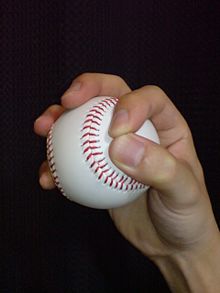Changeup

A changeup is a type of pitch in baseball and fastpitch softball. The changeup is the staple off-speed pitch, usually thrown to look like a fastball but arriving much more slowly to the plate. Its reduced speed coupled with its deceptive delivery is meant to confuse the batter's timing. It is meant to be thrown the same as a fastball, but farther back in the hand, which makes it release from the hand slower while still retaining the look of a fastball. A changeup is generally thrown to be 8–15 miles per hour slower than a fastball. If thrown correctly, the changeup will confuse the batter because the human eye cannot discern that the ball is coming significantly slower until it is around 30 feet from the plate.[1] For example, a batter swinging at the ball as if it were a 90 mph fastball when it is coming in at 75 mph means they are swinging too early to hit the ball well, making the changeup very effective.
Other names include change-of-pace, Bugs Bunny change-up, the dreaded equalizer and change.[citation needed] The changeup is an off-speed pitch, although that term can also be used simply to mean any pitch that is slower than a fastball. In addition, before at least the second half of the twentieth century, the term "slow ball" was used to denote pitches that were not a fastball or breaking ball, which almost always meant a type of changeup. Therefore, the terms slow ball and changeup could be used interchangeably.
The changeup is analogous to the slower ball in cricket.
Delivery
The changeup is thrown with the same arm action as a fastball, but at a lower speed due to the pitcher holding the ball in a special grip. Former pitcher and pitching coach Leo Mazzone stated:
"When a pitcher throws his best fastball, he puts more in it; the changeup is such that one throws something other than his best fastball. By having this mindset, the pitch will have less velocity on it in addition to the change in grips. This difference from what is expected by the arm action and the velocity can confuse the batter into swinging the bat far too early and thus receiving a strike, or not swinging at all. Should a batter be fooled on the timing of the pitch and still make contact, it will cause a foul ball or the ball being put into play weakly, usually resulting in an out. In addition to the unexpectedly slow velocity, the changeup can also [sic] possess a significant amount of movement, which can bewilder the batter even further. The very best changeups utilize both deception and movement."[2]
Popularity
Since the rise of Pedro Martínez, a Dominican pitcher whose changeup was one of the tools that led to his three Cy Young Awards, the changeup has become increasingly popular in the Dominican Republic.[3] Dominican pitchers including Edinson Vólquez, Michael Ynoa, and Ervin Santana are all known to have developed effective changeups in the Dominican Republic after Martínez's success with the pitch.[citation needed]
Hall of Famer reliever Trevor Hoffman had one of the best changeups in his prime and used it to record 601 saves.
In recent years, some of the game's best pitchers have relied heavily on the changeup. A 2013 article published by Sports Illustrated noted that Justin Verlander, Félix Hernández, Stephen Strasburg, David Price, and Max Scherzer have revolutionized the pitch and used it abundantly in their arsenal.[4]
Variations

There are several variations of changeups, which are generated by using different grips on the ball during the pitch.
The circle changeup is one well-known grip.[5] The pitcher forms a circle with the index finger and thumb and lays the middle and index fingers across the seams of the ball. By pronating the wrist upon release, the pitcher can make the pitch break in the same direction as a screwball. More or less break will result from the pitcher's arm slot. Pedro Martínez used this pitch throughout his career to great effect, and many considered it to be his best pitch.[6]
The most common type is the straight changeup. The ball is held with three fingers (instead of the usual two) and closer to the palm, to kill some of the speed generated by the wrist and fingers. This pitch generally breaks downward slightly, though its motion does not differ greatly from a two-seam fastball.
Other variations include the palmball, vulcan changeup and fosh. The split-finger fastball is used by many pitchers as a type of changeup.[citation needed]
References
- ^ Walsh, John (September 19, 2007). "Pitch Identification Tutorial". The Hardball Times. Retrieved 2007-09-19.
- ^ Mazzone, Leo, and Rosenthal, Jim (1999). Pitching Like a Pro: A Guide for Young Pitchers and Their Coaches, Little League Through High School. St. Martin's Press. ISBN 0-312-19946-5.
- ^ The Pitch of an Island, James Wagner
- ^ How the changeup has changed the game
- ^ "Changeup Grip". The Ultimate Pitcher. Archived from the original on 2012-06-29.
{{cite web}}: Unknown parameter|deadurl=ignored (|url-status=suggested) (help) - ^ James, Bill and Rob Neyer. The Neyer/James Guide to Pitchers Simon and Schuster, 2004. Pg. 12. ISBN 0-7432-6158-5.
